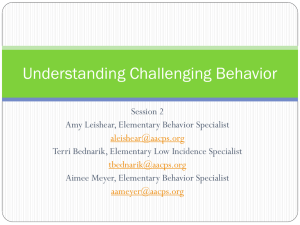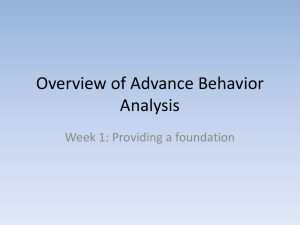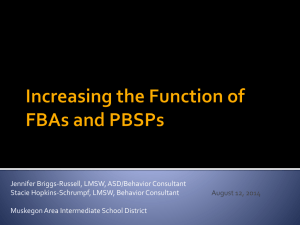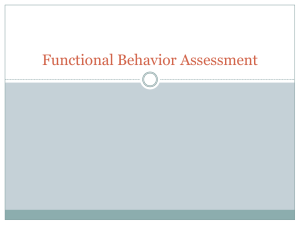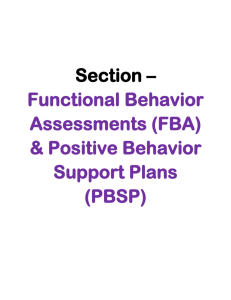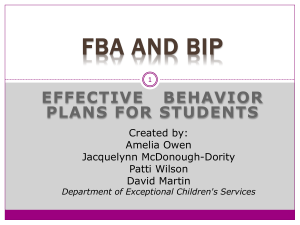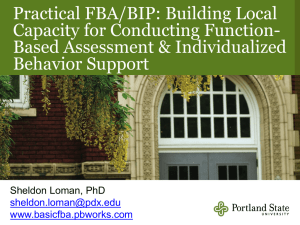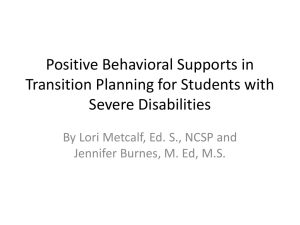and Behavior Support Plans - Hampton Township School District
advertisement
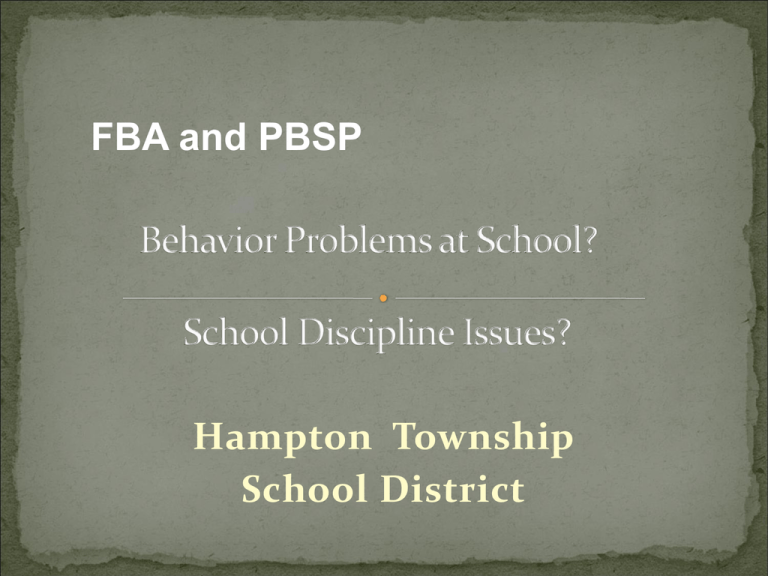
FBA and PBSP Hampton Township School District Free Appropriate Public Education (FAPE) Role of the IEP Team Functional Behavior Assessments (FBA) Positive Behavior Support Plans (PBSP) *Special Factors The IEP team shall, in the case of a child whose behavior impedes his or her learning or that of others, consider, where appropriate, strategies, including positive behavioral interventions, strategies, and supports that address that behavior. IDEA 300.346(2)(i) A new way of thinking about behavior Broadens intervention from only one approach - reducing challenging behavior to….. Encompasses multiple approaches: changing systems, altering environments, teaching skills, and appreciating (actively acknowledging) positive behavior 4 A team process for goal setting Functional Behavioral Assessment Behavior intervention plan design (PBSP), implementation, and evaluation This means that everyone is prepared to interact with the child in the same way. 5 In this section we will address the following questions…… What is an FBA? What are the requirements? When do we need to complete an FBA? What are the types of assessment? What does the FBA result in? FBA is a process for gathering information to understand the function (purpose) of behavior in order to write an effective positive behavior support plan. Behavior support programs and plans must be based on a functional assessment of behavior and utilize positive behavior techniques §14.133(a), §711.46(a) Does the student’s behavior impeded his/her learning or learning of others? Does the student’s behavior significantly differ from that of his/her classmates? Does the student’s behavior lessen the possibility of successful learning for the student and others? Have past efforts to address the student’s behavior using standard interventions been unsuccessful? Does the student’s behavior represent a behavioral deficit or excess, rather than a cultural difference? Is the student’s behavior serious, persistent, chronic, or a threat to the safety of the student or others? If the behavior persists, is some disciplinary action likely to result? 8 Behavior is learned and serves a specific purpose. To get To avoid Behavior is related to the context within which it occurs What is an FBA? Problem Behavior Escape/ Avoid Something Obtain/Get Something Stimulation/ Sensory Tangible/ Activity Social Adult Peer What are the levels of assessment? FBA LEVELS 1.Informal 2. Indirect/ Simple 3. Complex INFORMAL Archival EASIER Review ProblemSIMPLE Solving Meeting RESPONSIVE Checklist INDIRECT Functional Assessment Interview Initial Line of Inquiry DIRECT Brief Observation/Scatter Plot NOT RESPONSIVE COMPLICATED A-B-C data HARDER Structured, Direct Observation FORMAL Horner, R. & Sugai, G. (2007). Function based support: Selected topics. Retrieved from web 5/13/08 http://www.pbis.org/files/1107gsbrieffba.ppt 11 What is an FBA? All levels of FBA maintain the same goals: Define the target behavior. Identify the events/antecedent triggers that reliably predict the occurrence or nonoccurrence of the target behavior. Identify the consequences that maintain the behavior. Identify setting events that increase the likelihood of the occurrence of the targeted behavior IEP teams determine that the student’s behavior impedes his/her learning or that of others Start Conduct Functional Assessment Develop Positive Behavior Support Plan YES High Confidence in Hypothesis NO Satisfactory Improvement NO Conduct Full Functional Assessment YES Monitor & Modify PBSP Regularly Develop Positive Behavior Support Plan Horner, R. & Sugai, G. (2007). Function based support: Selected topics. Retrieved from web 5/13/08 http://www.pbis.org/files/1107gsbrieffba.ppt 13 1. Identify and agree on the behavior(s) that most need to change. 2. Determine where the behaviors occur and where they do not. Identify what may contribute to the behaviors. The team will ask some questions. 3. Collect data on the child’s performance from as many sources as possible. 4. Develop a hypothesis about why problem behaviors occur (the function of the behaviors). 5. Identify other behaviors that can be taught that will serve the same function for the child. 6. Address Antecedents and Consequences. The team develops and uses positive behavioral interventions that are written into the child’s IEP and/or positive behavior support plan. 7. Evaluate the success of the interventions. 8. Change or fine-tune the plan as needed. Define target behavior Collect data 1. 2. • • 3. 4. 5. Indirect measures Direct measures Formulate hypothesis (validate) Develop intervention plan (PBSP) Implement the plan, monitor and adjust 16 Will the FBA focus on the educational and behavioral needs of a specific child? • If so, then the FBA qualifies as an evaluation or reevaluation under IDEA and triggers the need to seek written parental consent. • If, the district uses an FBA as a widespread intervention tool to improve the behavior of all students in its schools, the FBA is not an evaluation and parental consent is not necessary. 17 Define target behavior Collect data 1. 2. • • 3. 4. 5. Indirect measures Direct measures Formulate hypothesis (validate) Develop intervention plan (PBSP) Implement the plan, monitor and adjust 18 Define target behavior Collect data 1. 2. • • 3. 4. 5. Indirect measures Direct measures Formulate hypothesis (validate) Develop intervention plan (PBSP) Implement the plan, monitor and adjust 19 • Initial Evaluation • Reevaluation – if the purpose of data collection is specific to an individual student’s educational and behavioral needs – if additional data is necessary to determine nature + extent of special education and related services needed to develop or modify behavior interventions and PBS in student’s IEP 20 • Reviewing existing data • Administering a test or other evaluation that is administered to all children, unless parent consent is required for all children • Review of behavior interventions in school as a whole • Screening to determine instructional strategies for curriculum implementation 21 Define target behavior Collect data 1. 2. • • 3. 4. 5. Indirect measures Direct measures Formulate hypothesis (validate) Develop intervention plan (PBSP) Implement the plan, monitor and adjust 22 What does the FBA result in? Problem behaviors are irrelevant Aversive events are removed Access to reinforcers are readily available Problem behaviors are inefficient Appropriate behavioral alternatives are taught Appropriate behavioral alternatives are known and used Problem behaviors are ineffective Problem behaviors are not reinforced Desired behavior ARE reinforced 24 Short term solution Manipulate Antecedents Manipulate Consequences Teach Socially Acceptable Functionally Equivalent Behavior Long term solution To remediate skill deficits so that the problem behavior is unnecessary To design consequences to maintain the new desired behaviors 4. Develop intervention plan (PBSP) Design Antecedent strategies Design Consequence strategies Select and teach replacement behaviors Implement the plan Monitor and adjust program 25 Antecedents to the behavior of concern Behavior of concern Consequences maintaining the behavior of concern When___(antecedents to the behavior of concern)______________ the student___(behavior of concern)_________________________ to___(perceived function of the behavior of concern)____________ Perceived function of the behavior of concern V. GOALS AND OBJECTIVES – Include, as appropriate, academic and functional goals. Use as many copies of this page as needed to plan appropriately. Specially designed instruction may be listed with each goal/objective or listed in Section VI. Short term learning outcomes are required for students who are gifted. The short term learning outcomes related to the student’s gifted program may be listed under Goals or Short Term Objectives. MEASURABLE ANNUAL GOAL Include: Condition, Name, Behavior, and Criteria (Refer to Annotated IEP for description of these components) Describe HOW the student’s progress toward meeting this goal will be measure d Describe WHEN periodic reports on progress will be provided to parents Report of Progress SHORT TERM OBJECTIVES – Required for students with disabilities who take alternate assessments aligned to alternate achievement standards (PASA). Short term objectives / Benchmarks VI. PROGRAM MODIFICATIONS AND SPECIALLY DESIGNED INSTRUCTION FOR THE POSITIVE BEHAVIOR SUPPORT PLAN: A B Antecedent (prevention) Strategies Replacement Behavior hC Consequences (reinforcement) for when the student performs the replacement behavior: iC Consequences (including procedures to follow) when the student performs the behavior of concern: – Measurable Annual Goal – Reasonable expectations within 12 month period – Must contain • Condition – situation, setting, or given material • Name – of the student • Behavior – the action the student will be expected to perform • Criteria – how we know the student has mastered the skill Measurable Annual Goal Must be a direct relationship between the FBA Results and the Annual Goal Progress Monitoring of the Goal How? When? Short Term Objectives Example During whole class and small group instruction and discussion, Chad will participate and decrease off-topic comments and discussions to no more than three offtopic comments and discussions per week over three consecutive weeks. Current baseline is average of twenty-one off-topic comments and discussions per week. • Manipulate the Antecedents • Teach an alternative Behavior • Manipulate the Consequences REMEDIATE THE SKILL DEFICITS Desired Behaviors – the behavior that you want the student to perform Long-term May or May Not Serve the Same Function Replacement Behaviors – the behavior you will teach the student to perform that serves the same function as the problem behavior Short Term Plan for fading Components Replacement Behavior (teaching and maintaining) • Identify functionally equivalent replacement behavior. Consider… • Is the replacement behavior effective and efficient for the student to use? • The Response Effort: how difficult is it for the person to perform the behavior? (physically and/or 34 cognitively) To Get/ Attention Escape Request a Work Check Rejecting “No thank you” Request Assistance-help Request a break from and attention Request Companionship Request Attention from staff, from peers activity, person Request an alternate activity Ask to work somewhere else • The FUNCTIONALLY EQUIVALENT and SOCIALLY ACCEPTABLE behavior that replaces the problem behavior • Must know the FUNCTION of problem behavior REPLACEMENT BEHAVIOR behavior CURSING AT STAFF function ESCAPE TASKS REPLACEMENT BEHAVIOR behavior CURSING AT STAFF function ESCAPE TASKS REQUEST ALTERNATIVE TASK REPLACEMENT BEHAVIOR CURSING ESCAPE TASK REQUEST ALTERNATIVE TASK CURSING ESCAPE TASK !?!? Must TEACH Replacement Behavior Must REINFORCE Replacement Behavior with SAME (or stronger) reinforcement as challenging behavior Manipulate the Antecedents Teach an alternative Behavior Manipulate the Consequences REMEDIATE THE SKILL DEFICITS Components Antecedent (prevention) strategies • Remove/reduce identified antecedents to the behavior of concern • Make the behavior unnecessary in specific situations •Assist with the performance of the replacement behavior (cues and prompts) •Long term strategies to remediate skill deficits 42 Setting Event Modifications – identify any changes that could make these events less likely or less influential. Antecedent Modifications – Identify changes that can be made in immediate antecedents to make problem behavior irrelevant. Consider the following Daily schedule Level of prompting/assistance Curriculum or features of task Groupings of students Daily Schedule Is it readable? Is it known? How many tasks before a break? Is it adhered to? Is it predictable? How much choice do students have in creating/modifying the schedule? Level of Prompting/Assistance Prime, Prompt, Fade, Reinforce Select the skill you will teach Determine the type of prompt that will be needed to make the learner successful Determine how the prompt will be faded To teach: Tell or show the learner exactly what you want him to do or say (Prime) Immediately prompt the learner Reinforce the learner Repeat and attempt to fade the prompt Components Consequence Strategies Reinforcement for performance of the replacement behavior that achieves the same function as the behavior of concern (get or escape). 47 Anything that increases a behavior Affects you like gravity – whether you are aware of it or not. Different for individuals Consumables Manipulative Activities Social Physical Personal Sundberg, 2009 Positive Reinforcement The delivery of something that increases a behavior Negative Reinforcement The removal of something that increases a behavior Edible Alarm clock Attention Telephone Money Requesting a break REINFORCEMENT must be related the FUNCTION of the Behavior 1. Timing – deliver reinforcers as soon as possible after the behavior 2. Quantity/Quality – reinforcers must be important enough to cause an increase in behavior 3. Contingency – must be a connection between the behavior and reinforcer 4. Deprivation/Satiation – do not overuse reinforcer Consequence Strategies The withholding of reinforcement for the behavior of concern. This ensures that the behavior of concern is less effective and efficient than the replacement behavior. **This is the section that includes the crisis plan (a plan to outline the steps taken to avoid a crisis as well as the plan for when a crisis occurs) 51 “Gain Something” “Escape Something” Function Function Withhold access to the Prevent or don’t allow for item, attention, etc. that the removal of the the student is attempting stimulus when the to gain access to when he student performs the or she performs the problem behavior problem behavior First response should ALWAYS be to PROMPT the STUDENT to PERFORM the REPLACEMENT BEHAVIOR! Token economy Response Cost Point systems Time out from Rf Level systems Planned ignoring Behavior contracts Extinction Differential “Broken Record” Reinforcement Personal Best Records http://www.pattan.net http://cecp.air.org/fba/default.asp http://www.aboutourkids.org/files/articles/nov_dec_2.pdf http://www.wrightslaw.com/info/discipl.fba.jordan.pdf
